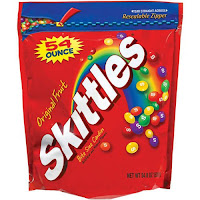Explore a real-life situation of growth & decay, simulated with M&Ms.
I like to do this lab just as we are first learning about exponential functions. It's a great lesson to do on a half day PD day or just before a long weekend/vacation or on a Friday.
There is some expense involved (don't all us teachers spend our own money supplying items for our classroom? There's always something we need for a lesson or to enrich our classroom environment that we are spending our own money on).
Supplies needed:
 A large quantity of skittles (I buy the "warehouse" size bag that you can get at a place like BJs or Sam's club. Amazon sells them too). I used to use M&Ms but skittles are better overall, you avoid any issue with allergies.
A large quantity of skittles (I buy the "warehouse" size bag that you can get at a place like BJs or Sam's club. Amazon sells them too). I used to use M&Ms but skittles are better overall, you avoid any issue with allergies.Paper cups (small ones are good - 6 ounce?)
Paper towels or large paper plates (or have students create a workplace* with a piece of paper).
Hand sanitizer (or have students wash hand before handling the food)
optional - small ziploc bags (for students who want to take leftover skittles with them)
*you can create a "workplace" for the skittles with an 8.5x11 sheet of paper. Just fold a small margin over on all four sides, then open it up a bit. It creates a workplace where they can empty our their skittles cup without the skittles going all over the place (like the floor!).
Additional Prep Work
For each group of students prepare the materials. Put two cups together and inside the cup put a generous handful of skittles (probably about 100, but I don't count them!). As for group size, I have the usually work in pairs or groups of 3. If you have too many people you'll have someone who isn't doing anything and you don't want anyone being idle when there is candy all around the room.
Starting the Lab
- Have the students get in their groups if they aren't already situated that way
- Hand out the lab information sheet and have students read it over. Discuss fish ponds and why populations grow or die off. Usually there are some students who fish in class and you can briefly discuss how ponds are "supplied" with fish just prior to fishing season.
- Hand out the supplies (cups with skittles, paper plate or paper towel or create the "workplace" noted above).
General Lab procedure
- Trial One - Growing Population - students need to follow the directions on the lab information sheet (they DO NOT eat the skittles, they are needed for the next trial). They collect their data. They may not get enough data to fill in the whole table - that's okay, just fill in enough until they have no more skittles (the last toss will tell them to add a certain number of skittles that they do not have - just tell them to calculate the total they should have and record that. Then they are done with trial one.
- Students can wait and do all the graphing calculator work after they collect their data, so they move on to...
- Trial Two - A Dying Pond - again students are following the directions on the lab information sheet and they may not use the whole table for data collection as in the first trial. They just collect data until they end up with one or zero fish.
- Once all the data is collected, students can eat their skittles. They should be doing work when they snack!
- Students do the graphing calculator portion of the lab - creating scatter plots of the data for each trial. If you haven't done so already talk about doing regression on the graphing calculator and how for exponential it will calculate "a" and "b" values for students. They should round "a" to the nearest whole number and "b" to the nearest tenth.
Examining the Results
Have students write results on the board. I write two headings- GROWING POPULATION
- DYING POND
Wrapping things up
der Now you can have a discussion of what those equations mean and this whole new type of function we'll be studying. You can have the students do an ISN insert summarizing or defining exponential functions or defining growth & decay. I haven't decided how I'm going to use my ISN in summarizing yet. My student teacher did this lab in class this past year. She actually used an ISN insert to drive the lab. I still like my lab sheets and think I just want my ISN insert to summarize.Here are her ISN inserts:





No comments:
Post a Comment